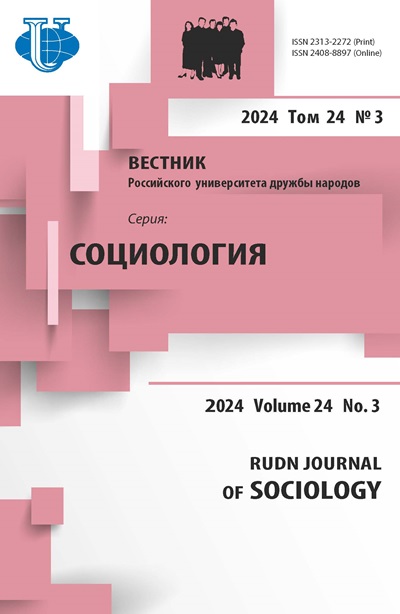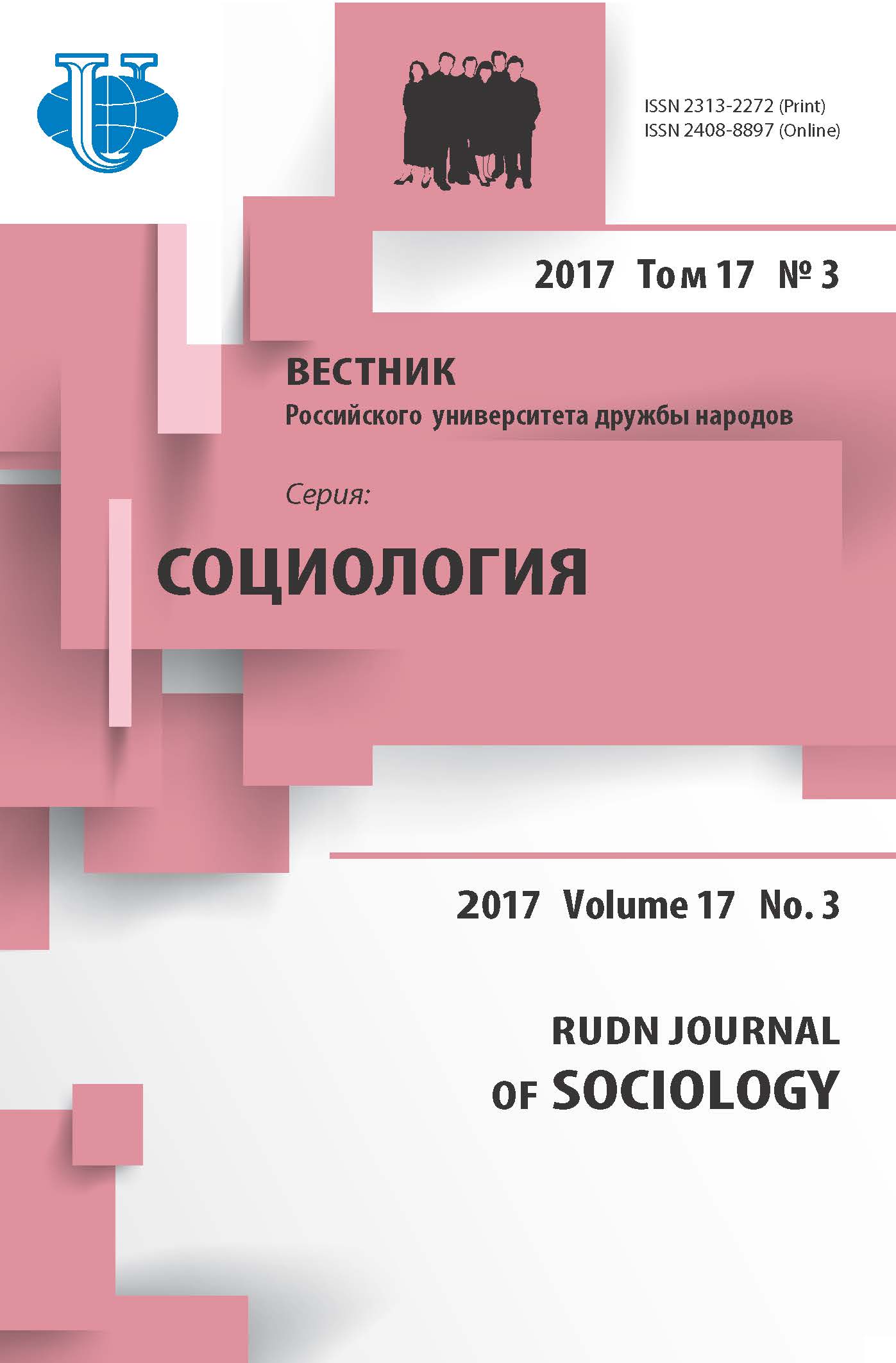Vol 17, No 3 (2017)
- Year: 2017
- Articles: 13
- URL: https://journals.rudn.ru/sociology/issue/view/996
- DOI: https://doi.org/10.22363/2313-2272-2017-17-3
Full Issue
Theory, Methodology and History of Sociological Research
THE ART OF NOT BEING GOVERNED: ORALITY, WRITING, AND TEXTS
Abstract
 267-288
267-288


AGRARIAN QUESTION AND ITS IMPACT ON THE DEVELOPMENT OF ETHIOPIA
Abstract
 299-305
299-305


THE STUDY OF SOCIAL REPRESENTATIONS BY THE VIGNETTE METHOD: A QUANTITATIVE INTERPRETATION
Abstract
 306-316
306-316


Surveys, experiments, case studies
CULTURAL IDENTITY AND ADAPTATION OF ETHNIC MIGRANTS IN RUSSIA
Abstract
The article presents the results of interviews with residents of Yekaterinburg (N = 485) and ethnic migrants from Central Asia (N = 231), which reveal the current forms of interaction between the host society and migrants from different countries, and the problem of mutual rejection that determines the growth of social conflicts. The authors identify key barriers hindering the mutual adaptation of the host society and migrants that are based on cultural differences and, thus, require a careful work with cultural identity as a determinant of interethnic interaction. However, the theoretical analysis proves the lack of a clear unambiguous interpretation of the ‘cultural identity’ concept that is necessary for the analysis of contem-porary social processes under the international migrations and intercultural communications. The article aims to prove the importance of both considering ‘cultural identity’ as a special analytical category and developing the common cultural identity in the process of mutual adaptation and integration of the Rus-sians and ethnic migrants. The authors use the constructivist approach and define ‘identity’ as a result of the identification process and a flexible element that can be changed according to the social situation. Thus, cultural patterns should become the basis of interethnic relations to ensure social well-being and stability, and cultural identity is to be the most important social construct to reduce social tensions de-termined by ethnic migrations. The development of a common social identity consists of several stages: first the common civil identity is to be formed, then the common cultural identity of the host society and ethnic migrants.
 317-326
317-326


ETHNIC STEREOTYPES IN INTERCULTURAL COMMUNICATION: THE UDMURTS’ STRATEGIES
Abstract
Based on the data of sociological research the article examines the influence of ethnic stereo-types on the choice of intercultural interaction strategies. The example of the Udmurt ethnos proves the importance of behavioral stereotypes as a program of interpersonal relations and a reference point in interac-tion with representatives of one’s own and other ethnic groups. The author identifies autostereotypes that reflect the emotional perception of ethnic identity and allow predicting further ways of ethnic development. Ethnic stereotypes of the Udmurts were determined by the influence of their cultural environment and adaptation to the social reality. The majority of Udmurts positively perceive their ethnic identity and recog-nize the uniqueness of ethnic culture and the need for positive interaction with other peoples, which explains the author’s cautious optimism when considering the future of the Udmurts. Their historical interaction with the cultural environment had various consequences: on the one hand, it explains the negative self-esteem of the ethnos including self-doubt; and uncertainty often leads to isolation and fear to show one’s cultural identity, and striving for social mimicry. Thus, the author considers the low social status of the Udmurts and their weak adaptive abilities as one of the key factors in strengthening the assimilation. On the other hand, the Udmurts opposition to the cultural domination of other ethnic groups makes them take an active stance and to seek ways to preserve their ethnic identity. Thus, the Udmurts of the Republic of Tatarstan should be as active as the ethnic majority of the region (the Tatars) in the search for new strategies of intercultural interaction and adaption to the social reality. The field ethnographic data allow the author to supplement statistical data with new facts, and help the readers to ‘hear’ the voices of the people and to ‘see’ their emotional perception of social and cultural realities.
 327-337
327-337


NEIGHBORING COUNTRIES’ IMAGES: PERSISTENT STEREOTYPES OF THE RUSSIAN STUDENT YOUTH
Abstract
 338-347
338-347


SOCIAL ACTIVITY OF THE RUSSIAN YOUTH: THE SCOPE AND RESTRAINING FACTORS
Abstract
In recent years, both experts and public opinion tend to assess the involvement of the Rus-sian youth in social activities as rather low: the post-Soviet generations are called apolitical and indifferent to anything except personal well-being and interests. At the same time, the largest research centers (Public Opinion Foundation, Russian Public Opinion Research Center, Levada Center, and Institute of Sociology) conduct sociological studies of various aspects of social and civil activities, political participation and protest potential of younger generations and Russian society as a whole. The article presents some recent data that prove the low level of political and social activity of the Russian population. The author believes that this level is higher among the younger generations, especially the students. To prove that, first, the author considers the category ‘social activity’: its motives (primarily socially significant needs), subjective ‘measurement’ (personal needs and interests), goals (pragmatic and altruistic, collective and personal, etc.), forms (personal, collective, etc.) and external and internal factors. Secondly, to assess the motives and restraining factors of the youth social activity, the article presents some results of the surveys conducted in the RUDN University and of the Russian public opinion polls. The author identifies reasons for the youth’s lack of interest in public activities (lack of material benefits, desire/time/motivation, information, and nega-tive image of public associations), motives of social activity (social, selective, mobilization, etc.) and for be-coming a member of public associations (self-realization, the desire to change the world, combination of the two, etc.), and factors that determine the youth’s perception of social activity in general (estimates of so-cial situation, value orientations and social well-being).
 348-363
348-363


LGBT COMMUNITY IN THE FOCUS OF SOCIOLOGICAL RESEARCH
Abstract
 364-372
364-372


Sociological lectures
INTERACTION OF DIFFERENT SPHERES OF SOCIETY AS TYPES OF PEOPLE’S JOINT ACTIVITY
Abstract
The article considers one of the most urgent and topical issues for the contemporary socio-logy - how to study society and its constituent parts. There are many interdisciplinary and special studies of the issue; however, to understand the nature of society we are to apply methods of both general sociology and social philosophy for the latter enriches social science with a new perception of the object under study through the prism of its universal features. The author proposes to conduct social analysis with the methods of system and activity approaches as the principles explaining both different social processes and society as a whole. These methods also reveal the nature of society as based on the activities of people pursuing their goals. The article focuses on the specificity of social relations and their differences from natural phenomena, the value measurement of social facts and their subjective nature, freedom as a human ability to control external conditions in pursuing individual and collective goals. When considering the structure of human activity and its key components, the author identifies four types of collective activity according to the well-known spheres of social life, and revises the categorical apparatus of social analysis. The author explains why it is incorrect to consider the economic sphere as a separate structure for there are economic elements in all spheres of society; shows the mechanism of interaction of all types of collective activity and spheres of society, their interconnection and mutual influence; identifies some ways to study society with the system-activity approach; emphasizes the importance of revealing ontological and epistemological grounds at the very beginning of the social processes study to optimize its course and methodology.
 373-386
373-386


TECHNOPARKS AND SCIENCE-INTENSIVE PRODUCTION: AN ADVANCED EXPERIENCE
Abstract
 387-398
387-398


Reviews
Anti-Semitism yesterday and Islamophobia today: A Central-European perspective
Abstract
 399-407
399-407


Symbolic protest: Hidden messages and addressers. Review of the book: Gorodskie teksty i praktiki. Vol. I: Simvolicheskoe soprotivlenie [Urban Texts and Practices. Vol. I: Symbolic Resistance] / Sost. A.S. Arhipova, D.A. Radchenko, A.S. Titkov. Moscow: Izdatelskij dom “Delo” RANHiGS, 2017. 324 p
 408-419
408-419


 420-435
420-435

















